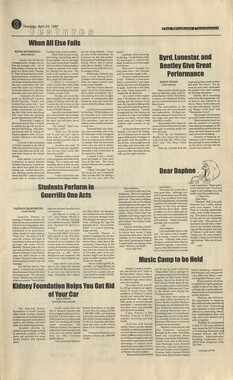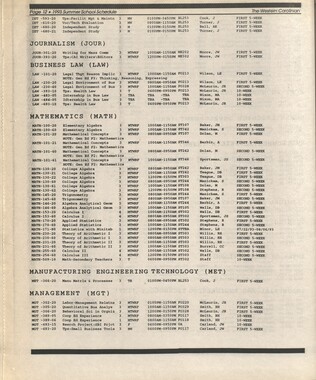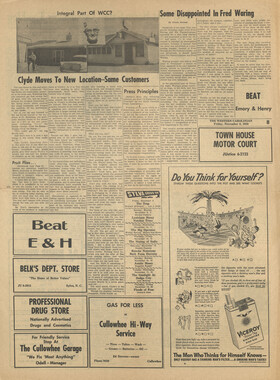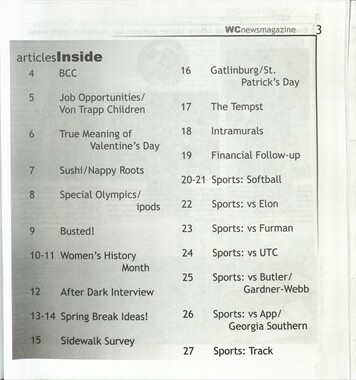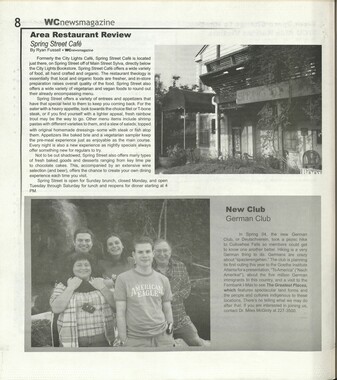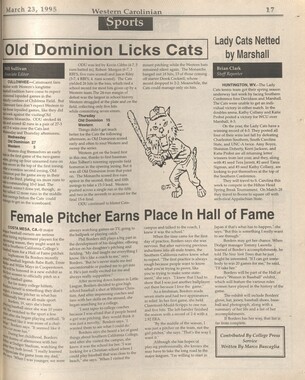Western Carolina University (21)
View all
- Canton Champion Fibre Company (2308)
- Cherokee Traditions (291)
- Civil War in Southern Appalachia (165)
- Craft Revival (1942)
- George Masa Collection (137)
- Great Smoky Mountains - A Park for America (3182)
- Highlights from Western Carolina University (422)
- Horace Kephart (998)
- Journeys Through Jackson (159)
- LGBTQIA+ Archive of Jackson County (90)
- Oral Histories of Western North Carolina (318)
- Picturing Appalachia (6617)
- Stories of Mountain Folk (413)
- Travel Western North Carolina (153)
- Western Carolina University Fine Art Museum Vitreograph Collection (129)
- Western Carolina University Herbarium (92)
- Western Carolina University: Making Memories (738)
- Western Carolina University Publications (2491)
- Western Carolina University Restricted Electronic Theses and Dissertations (146)
- Western North Carolina Regional Maps (71)
- World War II in Southern Appalachia (131)
University of North Carolina Asheville (6)
View all
- Allanstand Cottage Industries (62)
- Appalachian National Park Association (53)
- Bennett, Kelly, 1890-1974 (1463)
- Berry, Walter (76)
- Brasstown Carvers (40)
- Carver, George Washington, 1864?-1943 (26)
- Cathey, Joseph, 1803-1874 (1)
- Champion Fibre Company (233)
- Champion Paper and Fibre Company (297)
- Cherokee Indian Fair Association (16)
- Cherokee Language Program (22)
- Crowe, Amanda (40)
- Edmonston, Thomas Benton, 1842-1907 (7)
- Ensley, A. L. (Abraham Lincoln), 1865-1948 (275)
- Fromer, Irving Rhodes, 1913-1994 (70)
- George Butz (BFS 1907) (46)
- Goodrich, Frances Louisa (120)
- Grant, George Alexander, 1891-1964 (96)
- Heard, Marian Gladys (60)
- Kephart, Calvin, 1883-1969 (15)
- Kephart, Horace, 1862-1931 (313)
- Kephart, Laura, 1862-1954 (91)
- Laney, Gideon Thomas, 1889-1976 (439)
- Masa, George, 1881-1933 (61)
- McElhinney, William Julian, 1896-1953 (44)
- Niggli, Josephina, 1910-1983 (10)
- North Carolina Park Commission (105)
- Osborne, Kezia Stradley (9)
- Owens, Samuel Robert, 1918-1995 (11)
- Penland Weavers and Potters (36)
- Roberts, Vivienne (15)
- Roth, Albert, 1890-1974 (142)
- Schenck, Carl Alwin, 1868-1955 (1)
- Sherrill's Photography Studio (2565)
- Southern Highland Handicraft Guild (127)
- Southern Highlanders, Inc. (71)
- Stalcup, Jesse Bryson (46)
- Stearns, I. K. (213)
- Thompson, James Edward, 1880-1976 (226)
- United States. Indian Arts and Crafts Board (130)
- USFS (683)
- Vance, Zebulon Baird, 1830-1894 (1)
- Weaver, Zebulon, 1872-1948 (58)
- Western Carolina College (230)
- Western Carolina Teachers College (282)
- Western Carolina University (2008)
- Western Carolina University. Mountain Heritage Center (18)
- Whitman, Walt, 1819-1892 (10)
- Wilburn, Hiram Coleman, 1880-1967 (73)
- Williams, Isadora (3)
- Cain, Doreyl Ammons (0)
- Crittenden, Lorraine (0)
- Rhodes, Judy (0)
- Smith, Edward Clark (0)
- Appalachian Region, Southern (3032)
- Asheville (N.C.) (1945)
- Avery County (N.C.) (26)
- Blount County (Tenn.) (200)
- Buncombe County (N.C.) (1680)
- Cherokee County (N.C.) (283)
- Clay County (N.C.) (556)
- Graham County (N.C.) (247)
- Great Smoky Mountains National Park (N.C. and Tenn.) (535)
- Haywood County (N.C.) (3573)
- Henderson County (N.C.) (70)
- Jackson County (N.C.) (4926)
- Knox County (Tenn.) (61)
- Knoxville (Tenn.) (21)
- Lake Santeetlah (N.C.) (14)
- Macon County (N.C.) (421)
- Madison County (N.C.) (216)
- McDowell County (N.C.) (39)
- Mitchell County (N.C.) (135)
- Polk County (N.C.) (35)
- Qualla Boundary (982)
- Rutherford County (N.C.) (78)
- Swain County (N.C.) (2187)
- Transylvania County (N.C.) (270)
- Watauga County (N.C.) (12)
- Waynesville (N.C.) (86)
- Yancey County (N.C.) (72)
- Aerial Photographs (3)
- Aerial Views (60)
- Albums (books) (4)
- Articles (1)
- Artifacts (object Genre) (228)
- Bibliographies (1)
- Biography (general Genre) (2)
- Cards (information Artifacts) (38)
- Clippings (information Artifacts) (193)
- Copybooks (instructional Materials) (3)
- Crafts (art Genres) (622)
- Depictions (visual Works) (21)
- Design Drawings (1)
- Digital Moving Image Formats (2)
- Drawings (visual Works) (185)
- Envelopes (115)
- Exhibitions (events) (1)
- Facsimiles (reproductions) (1)
- Fiction (general Genre) (4)
- Financial Records (12)
- Fliers (printed Matter) (67)
- Glass Plate Negatives (381)
- Guidebooks (2)
- Internegatives (10)
- Interviews (823)
- Land Surveys (102)
- Letters (correspondence) (1070)
- Manuscripts (documents) (618)
- Maps (documents) (177)
- Memorandums (25)
- Minutes (administrative Records) (59)
- Negatives (photographs) (6192)
- Newsletters (1290)
- Newspapers (2)
- Notebooks (8)
- Occupation Currency (1)
- Paintings (visual Works) (1)
- Pen And Ink Drawings (1)
- Periodicals (194)
- Personal Narratives (10)
- Photographs (12977)
- Plans (maps) (1)
- Poetry (6)
- Portraits (4573)
- Postcards (329)
- Programs (documents) (181)
- Publications (documents) (2444)
- Questionnaires (65)
- Relief Prints (26)
- Sayings (literary Genre) (1)
- Scrapbooks (282)
- Sheet Music (2)
- Slides (photographs) (402)
- Songs (musical Compositions) (2)
- Sound Recordings (802)
- Specimens (92)
- Speeches (documents) (18)
- Tintypes (photographs) (8)
- Transcripts (329)
- Text Messages (0)
- A.L. Ensley Collection (275)
- Appalachian Industrial School Records (7)
- Appalachian National Park Association Records (336)
- Axley-Meroney Collection (2)
- Bayard Wootten Photograph Collection (20)
- Bethel Rural Community Organization Collection (7)
- Blumer Collection (5)
- C.W. Slagle Collection (20)
- Canton Area Historical Museum (2110)
- Carlos C. Campbell Collection (564)
- Cataloochee History Project (64)
- Cherokee Studies Collection (4)
- Daisy Dame Photograph Album (5)
- Daniel Boone VI Collection (1)
- Doris Ulmann Photograph Collection (112)
- Elizabeth H. Lasley Collection (1)
- Elizabeth Woolworth Szold Fleharty Collection (4)
- Frank Fry Collection (95)
- George Masa Collection (173)
- Gideon Laney Collection (452)
- Hazel Scarborough Collection (2)
- Hiram C. Wilburn Papers (28)
- Historic Photographs Collection (236)
- Horace Kephart Collection (861)
- Humbard Collection (33)
- Hunter and Weaver Families Collection (1)
- I. D. Blumenthal Collection (4)
- Isadora Williams Collection (4)
- Jesse Bryson Stalcup Collection (47)
- Jim Thompson Collection (224)
- John B. Battle Collection (7)
- John C. Campbell Folk School Records (80)
- John Parris Collection (6)
- Judaculla Rock project (2)
- Kelly Bennett Collection (1482)
- Love Family Papers (11)
- Major Wiley Parris Civil War Letters (3)
- Map Collection (12)
- McFee-Misemer Civil War Letters (34)
- Mountain Heritage Center Collection (4)
- Norburn - Robertson - Thomson Families Collection (44)
- Pauline Hood Collection (7)
- Pre-Guild Collection (2)
- Qualla Arts and Crafts Mutual Collection (12)
- R.A. Romanes Collection (681)
- Rosser H. Taylor Collection (1)
- Samuel Robert Owens Collection (94)
- Sara Madison Collection (144)
- Sherrill Studio Photo Collection (2558)
- Smoky Mountains Hiking Club Collection (616)
- Stories of Mountain Folk - Radio Programs (374)
- The Reporter, Western Carolina University (510)
- Venoy and Elizabeth Reed Collection (16)
- WCU Gender and Sexuality Oral History Project (36)
- WCU Mountain Heritage Center Oral Histories (25)
- WCU Oral History Collection - Mountain People, Mountain Lives (71)
- WCU Students Newspapers Collection (1923)
- Western North Carolina Tomorrow Black Oral History Project (69)
- William Williams Stringfield Collection (2)
- Zebulon Weaver Collection (109)
- African Americans (390)
- Appalachian Trail (35)
- Artisans (521)
- Cherokee art (84)
- Cherokee artists -- North Carolina (10)
- Cherokee language (21)
- Cherokee pottery (101)
- Cherokee women (208)
- Church buildings (190)
- Civilian Conservation Corps (U.S.) (114)
- College student newspapers and periodicals (2012)
- Dams (115)
- Dance (1023)
- Education (222)
- Floods (63)
- Folk music (1015)
- Forced removal, 1813-1903 (2)
- Forest conservation (220)
- Forests and forestry (1198)
- Gender nonconformity (4)
- Great Smoky Mountains National Park (N.C. and Tenn.) (181)
- Hunting (47)
- Landscape photography (25)
- Logging (122)
- Maps (83)
- Mines and mineral resources (9)
- North Carolina -- Maps (18)
- Paper industry (38)
- Postcards (255)
- Pottery (135)
- Railroad trains (72)
- Rural electrification -- North Carolina, Western (3)
- School integration -- Southern States (2)
- Segregation -- North Carolina, Western (5)
- Slavery (5)
- Sports (452)
- Storytelling (243)
- Waterfalls -- Great Smoky Mountains (N.C. and Tenn.) (66)
- Weaving -- Appalachian Region, Southern (280)
- Wood-carving -- Appalachian Region, Southern (328)
- World War, 1939-1945 (174)
Western Carolinian Volume 78 Number 16
Item
Item’s are ‘child’ level descriptions to ‘parent’ objects, (e.g. one page of a whole book).
-
-
en ois tag OT ts pot sss nee ay eT Si: 2300 BPR ay _apanot te hte, eR ersnee aca ea Se cadet? ee Sites, pretty N28 np THE WESTERN. CAROLINIAN FRIDAY June 21, 2013 Lex Menz Editor-in-Chief Western Carolina Uni- versity recently released a program prioritization recommendation list that categorized all of its academic programs by looking at several numerical factors. On the list, eight pro- grams were recognized as excellent and to be considered for additional funding, five were rec- ommended to implement .an action plan to better _ their program, and 13 are marked for Chan- cellor David Belcher to consider discontinuing the program, Programs listed for possible discontinuation are a minor in wom- ens studies, a minor in broadcast sales, a bachelors in German, a bachelors in Spanish and Spanish education, a bachelors in motion picture and television production, a masters in mathematics and mathematics education, _amasters in music and music education, a mas- ters in teaching English to speakers of other lan- - guages, and a masters in health and physical education. These pro- grams were described by the report as showed weak quantitive data and/or worsening trends, coupled with _qualitive narratives that did not clearly articulate connections Brown bring Tyler Auffhammer. ~ News Editor David J: Brown,an | experienced arts profes-. sional that has worked in the field of art and visual culture for more than 25 years, will take over as director of the Fine Arts Museum at Western Carolina Uni- versity effective July 1, following the retirement of founding director and curator Martin DeWitt - in'December 2010. Brown has worked as an arts management consultant since 2010. From 2007 to 2010, he was deputy director of the Taubman Museum of Artin Roanoke, Va. Brown has also served in administrative roles with the Southeastern Center for Contempo- rary Art in Winston- Salem, the Maryland Institute College of Art in Baltimore and the Contemporary Arts Cen- terin Cincinnati. , He has worked with artists including Pae White, Laurie Ander- * son, Yoko Ono, Willie Doherty, Lesley Dill, David Byrne, John Wa- ters and Dan Perjovs- chi, according to WCU News Services. -Brown earned his masters of fine arts degree from Virginia Commonwealth Univer- sity, a bachelors of fine arts degree from Old Dominion University, and a certificate in non- profit management from Duke University. When asked about his plans for the Fine Arts Museum, Brown said, Its not my intention to come in with a set pro- gram in mind without . getting to know the orga- nization, the school and the communityfinding out the resources and talent that defines the area and working with ' at five years of data, www.wcu ws.com Photo by Lex Menz/STAFF (From left) Mark Lord, Vicki Szabo, Chancellor David Belcher and Beth poriuist answer questions at the faculty forum. with WCUs mission or strategic plan. . . The report was com- piled by alargetask - force, co-chaired by the late Provost Angi Bren- ton. Mark Lord, interim associate provost and professor, took over to work alongside co-chair Vicki Szabo, Dean of the Honors College Brian Railsback, several pro- fessors and two student representatives, Jannidy Gonzalez and John Bal- ey. The task force looked David J. Brown that wealth of knowledge and history to begin to realize what is possible. All of that combines with all of the programs that Ive been involved with over the years. Ive always maintained that there is no shortage of good ideas, just ways to fund them so fundraising will certainly be crucial in helping to raise the profile of the museum lo- cally, regionally, nation- ally, said Brown. As WCU resides in the rural mountains, fine arts are often lost to more outdoors activities. Brown said that get- ting students in arural setting to come visit a Fine Arts Museum is [a question] pertinent to most areas outside of major cities that are rich with cultural offerings. -. ber of students enrolled - which coincided with the development and usage of Banner, according to the report. Directors of bachelors programs were asked to provide a list of data points along , with a 600-word essay about the program. Data points included numbers for majors enrolled, cost of the program, degrees awarded, and retention and graduation rates. Minor programs were asked to compile data that looked at the num- E One of my goals will be to make the museum more of a social space with active participants rather than passive view- ers, continued Brown. Another idea is to bring the museum activities out into campus and the community so that our students and the commu- nity dont always have to come into the museum to experience that which we call art these days. Brown said it is too early to tell what chang- es need to be made at the Fine Arts Museum. T haven't had the op- ' portunity to meet all the staff and really assess the program but that. will happen fairly soon. I tend to practice a servant management style which is based on listening to others, respecting what and the number of graduates at the end of each term along witha 600-word statement. Some directors found ' the process of compil- ing the list inefficient and were shocked to see their program on the discontinued or needing an action plan list. In the next phase, direc- tors will plead their case . to Belcher as to why he should not discontinue - _ their program. _ Thomas. Salzman, they have to offer and encouraging them to seek greatness, said Brown. Brown does know that he wants to increase the museums budget and visibility, making ita major player in the state and region For Brown, art has always been a part. of his life. . T think I started draw- ing in the 2nd grade and _ continued to do so on and . off over the years. I played drums in a few bands in my teens, and there was this zone that one would enter playing music whereby you were so com- pletely immersed in the activity that everything outside of the playing disappeared. I found that same zen-like zone when Istarted painting in col- lege, said Brown. Stage & Screen, faces the need to create an action plan for the bachelors in stage and screen. He stated that he was very surprised to see the program on the list because this program is the least expensive program to deliver in our School, and it has shown good growth since its redesignin - 2009... I believe that the conclusions reached by the committee for the degree programs in our School were misguided. After graduate school, Brown would volunteer _any time that he had working with other artists on their projects and, overtime, built up quite a bit of experience in doing all kinds of _artistic based projects. In my case, my mind worked much faster than my hands and that even- tually became a driving force or direction for Ime. It became evident at one point that I needed to close the doors to my studio and do all my creative work within the institutional frame- work, said Brown. For Brown, moving to the WNC area will bea treat. Brown spent time driving across country many years ago and remembers quite vividly that fhe Southwest North ) See CUT, page A3 Vol. 78, No. 16 FREE . We are taking this very seriously. While Salzman will not make a presentation td Belcher for the bachelors in stage and screen, he is concerned about another program in his School. They actually did not cite a weakness, in fact. They said, Stage & Screen is a unique program that prepares students broadly for entertainment fields, as compared to other programs at peer insti- tutions. However, they still want us to eliminate the film aspect of our program. We totally disagree since that is one of the unique aspects of this program as opposed to the other BA theater degrees in the state system, said Salzman. We believe passion- ately about all of our programs at the School of Stage & Screen. In the past five years, we have -grown the School from 127 majors to 174 majors last year, and we believe that growth is because of our integration of Theatre and Film. If al- lowed, we intend to con- tinue to grow this strong and unique program. The motion picture and television produc- tion [MPTP] program . -in the School of Stage & Screen was categorized as a three, or recom- mended for discontinua- - tion, by the task force. Photo by David J. Brown Carolina/Eastern Ten- nessee region was by far his favorite. Its not new news to tell you how gorgeous the ara is. In my role as a director, its impor- tant for me to havea presence in Cullowhee and also in the greater region, said Brown. He has lived in North Carolina since 1999 and knows many of the peo- ple in the art and culture sectors, including many of the funders. Brown said, Im personally looking for- ward to learning more about Cullowhee and in searching for possible partners to collaborate with: The arts dont exist in a vacuum, and creative people in all sorts of disciplines live everywhere these days.
Object
Object’s are ‘parent’ level descriptions to ‘children’ items, (e.g. a book with pages).
-
The Western Carolinian is Western Carolina University's student-run newspaper. The paper was published as the Cullowhee Yodel from 1924 to 1931 before changing its name to The Western Carolinian in 1933.
-

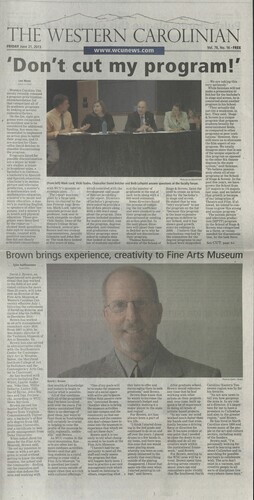
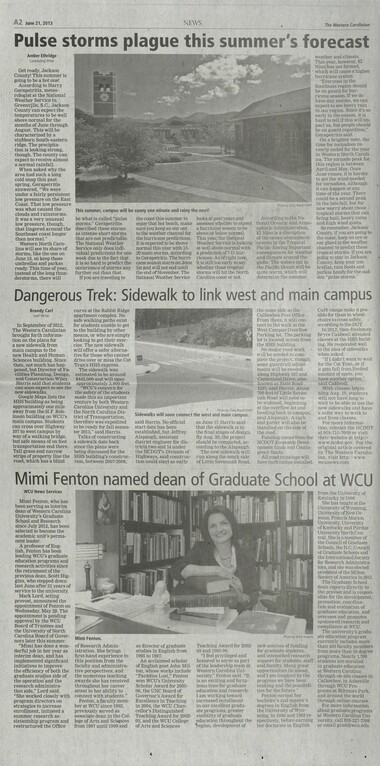

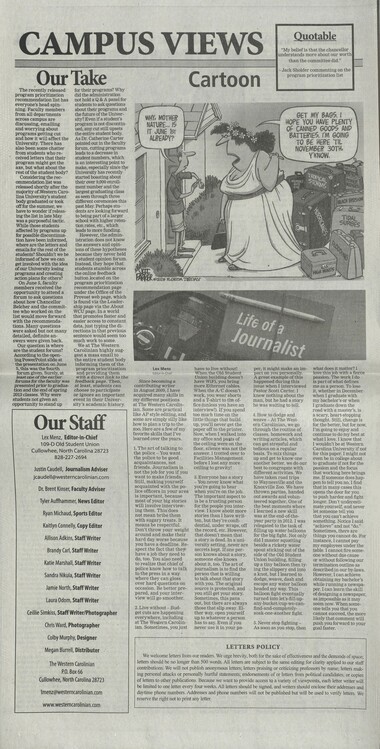


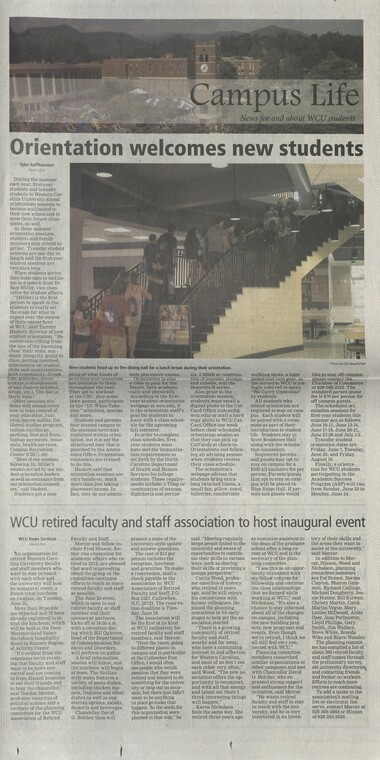
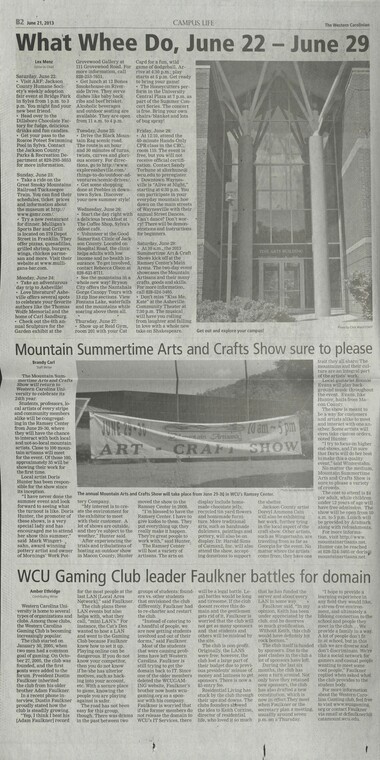
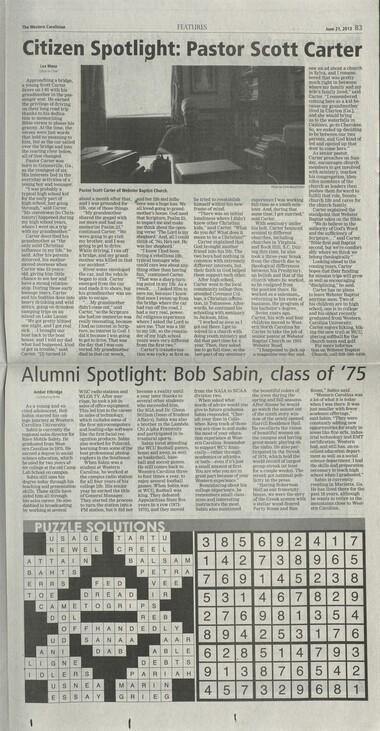



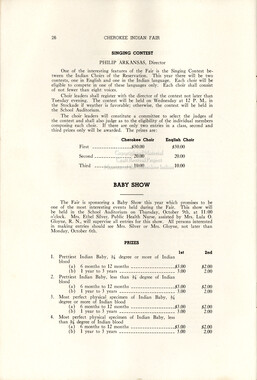

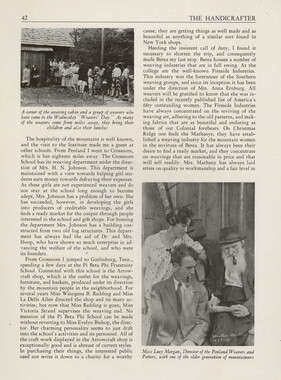
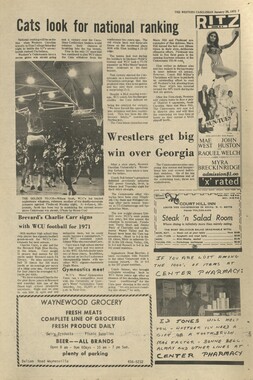

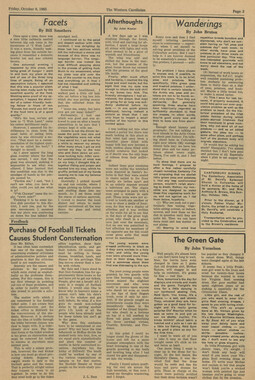
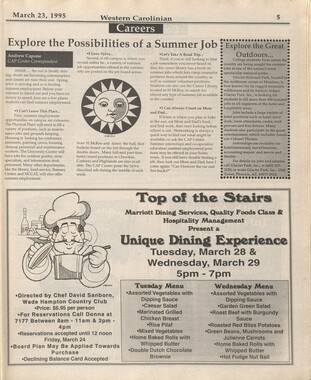
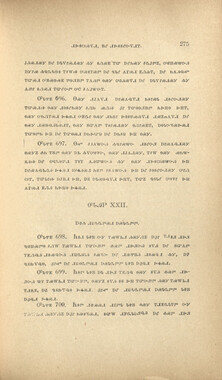

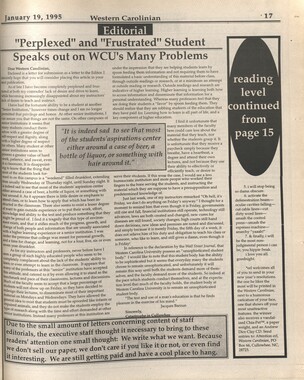
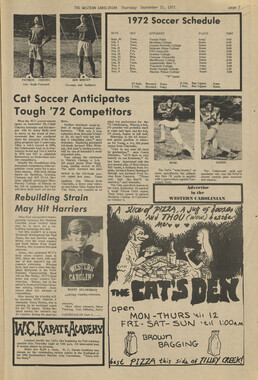
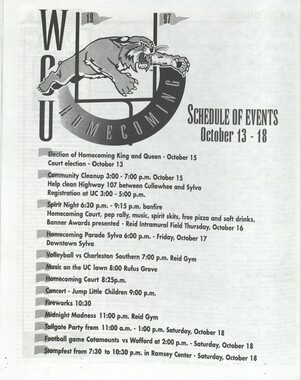
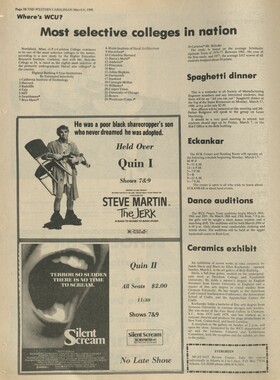
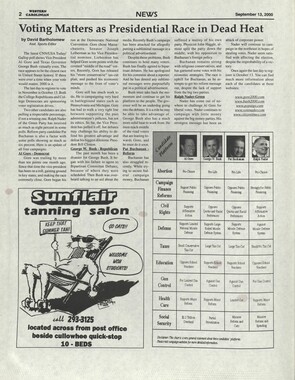
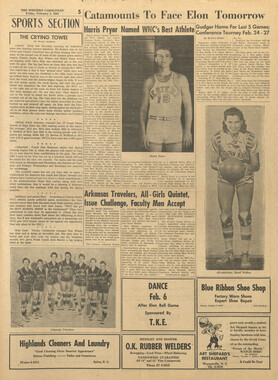
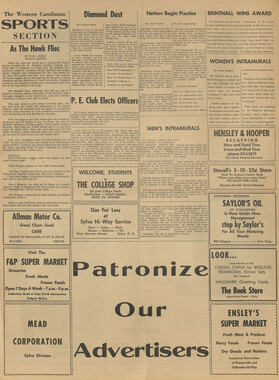
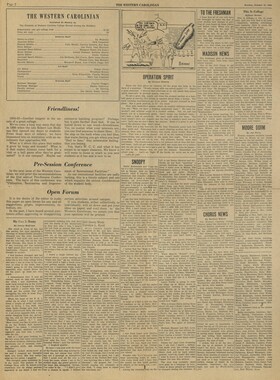
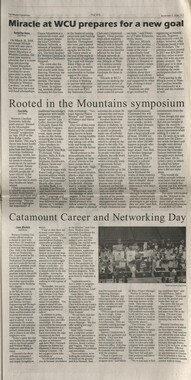
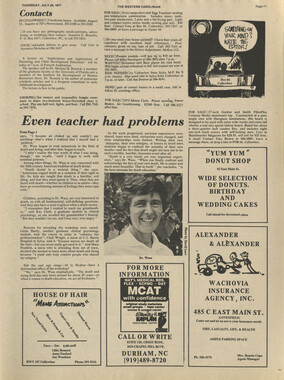

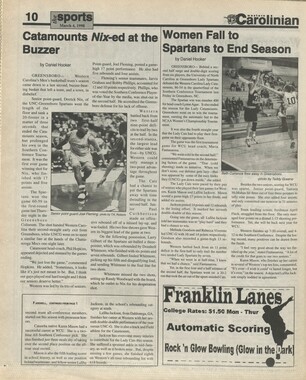

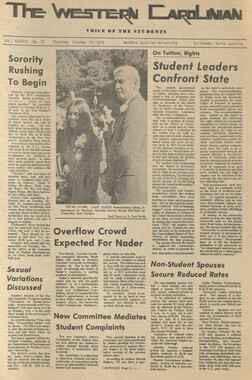
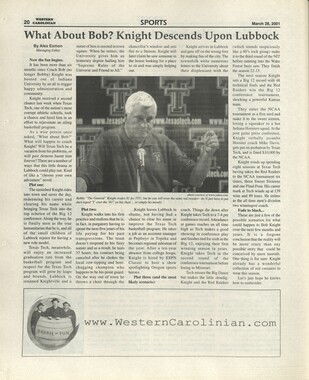
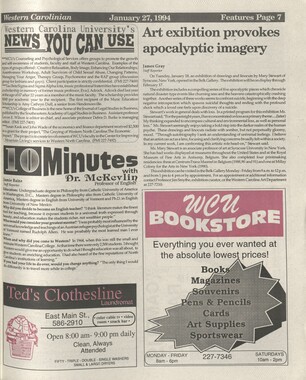
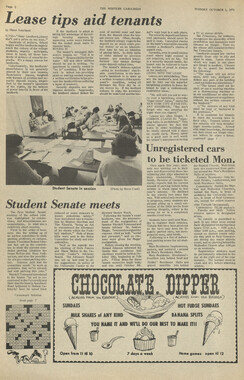

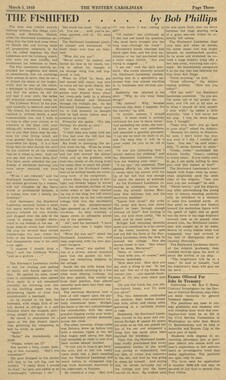

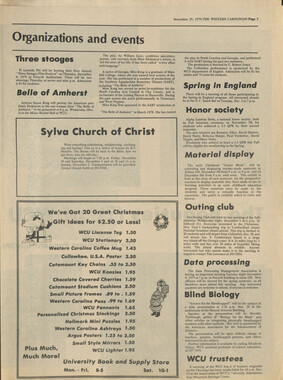
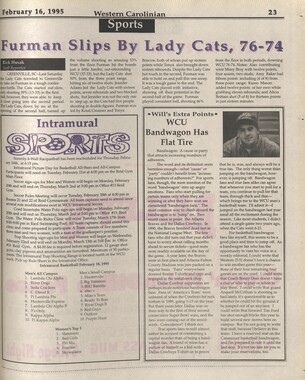

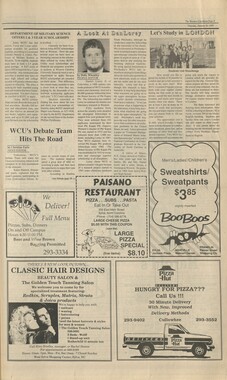

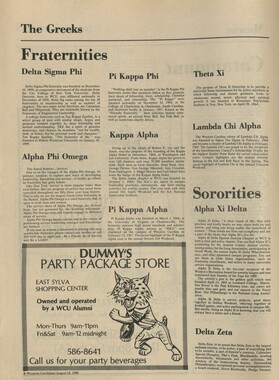
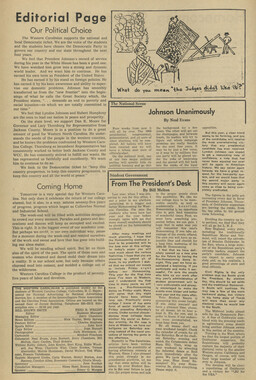
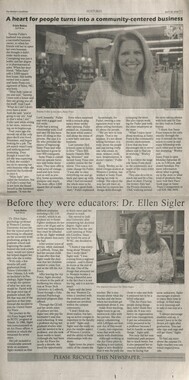
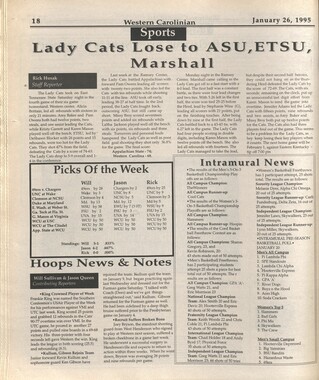
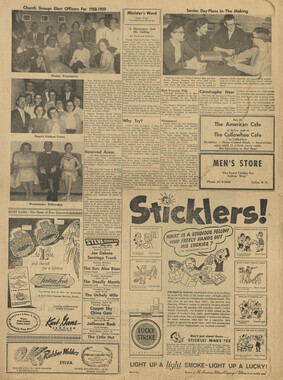

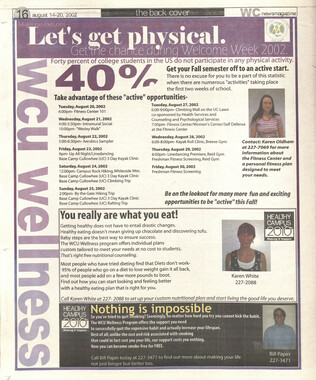
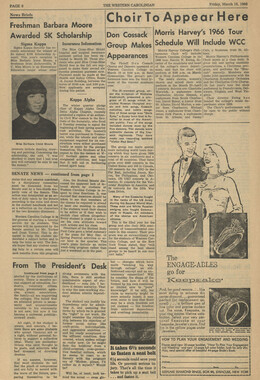





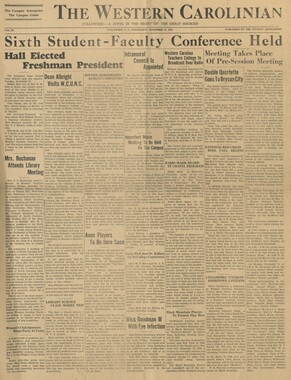

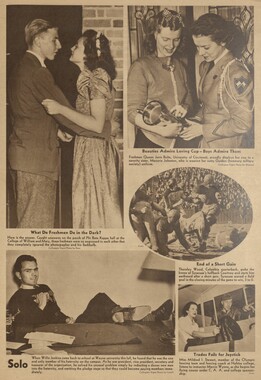
![hl_westerncarolinian_2004_[vol69_no04]_01.jpg](/media/w400h300/wcu_publications/hl_westerncarolinian_2004_[vol69_no04]_01.jpg)
